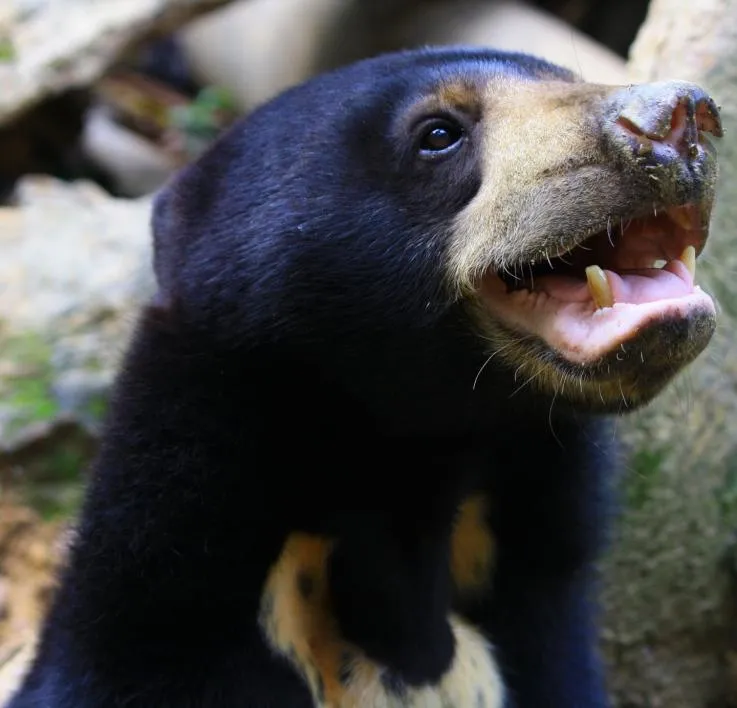Sun Bears Mimic Each Other’s Facial Expressions to Communicate
Previously, precise facial mimicry has only been observed in humans and gorillas
/https://tf-cmsv2-smithsonianmag-media.s3.amazonaws.com/filer/64/a9/64a97737-e83c-47e7-864c-aa7af3f63e03/sepilok_sabah_bsbcc-photos-by-wong-siew-te-02.jpg)
When comparative psychologist Marina Davila-Ross set out to study orangutans at a wildlife rehabilitation center in Borneo, she had no idea that she’d soon make a landmark discovery regarding an entirely different species. Still, upon finding herself drawn to the demure animals at the nearby Bornean Sun Bear Conservation Centre, the University of Portsmouth researcher decided to switch gears, focusing instead on the little-studied sun bear’s surprisingly complex communication skills.
As Jake Buehler reports for National Geographic, Davila-Ross and her colleagues found that sun bears—somewhat reclusive, Rottweiler-sized Southeast Asian rainforest dwellers best-known as the world’s smallest bears—are capable of mimicking each other’s facial expressions with a level of precision previously believed to be unique to humans and gorillas. The findings, newly published in Scientific Reports, suggest such advanced behavior isn’t limited to famously social creatures, but can also be practiced by animals that lead more solitary lives.
According to Gizmodo’s Ryan F. Mandelbaum, the team spent two years observing 22 sun bears—aged 2 to 12 years—housed at the Bornean facility. Across 372 recorded instances of play, the scientists spotted two main recurring facial expressions: One saw the animal raising its upper lip and nose to reveal the upper incisors, while the other found the bear opting to hide its teeth.
Around 20 percent of the time, Amber Jorgenson writes for Discover, the bears returned a playmate’s expression within one second of seeing it. If one bear offered up a toothy grin, its partner mirrored the exact same movement 82 percent of the time; when a toothless expression was at play, mimicking occurred closer to 72 percent of the time.
Overall, the researchers report that the sun bears were more likely to reflect facial expressions during gentle, rather than rough, play. Although the creatures are notoriously solitary in the wild, New Scientist notes that the study points toward their use of facial mimicry to indicate readiness for rough play or building heightened social bonds.

Until now, humans, certain non-human primate species and domesticated dogs were the only animals known to change their facial expression in response to another’s actions. As National Geographic’s Buehler observes, the exact expression matching achieved by sun bears was thought to be an elusive behavior perfected solely by humans and gorillas.
Compared to primates and dogs, sun bears are far less social, preferring to forge their own paths rather than settle down in large hierarchical groups.
“We know they live in tropical rainforests, eat almost everything, and that outside of the mating season adults have little to do with one another,” Derry Taylor, a University of Portsmouth PhD student and co-author of the study, says in a press release. “That's what makes these results so fascinating—they are a non-social species who when face to face can communicate subtly and precisely.”
Moving forward, Elisabetta Palagi, a biologist at the University of Pisa who was not involved in the research, tells Gizmodo’s Mandelbaum that she would like to see a study that gauges how familiarity affects facial mimicry. Expanding on this thought in an interview with Buehler, she adds that the bears highlighted by the new paper live in a communal environment anathema to that seen in the wild. Given the close nature of these quarters, Palagi posits that the animals become familiar with each other and may find it easier to learn various social cues.
Speaking with Newsweek’s Kashmira Gander, Taylor highlights two potential avenues for further research. He explains, “One possibility raised by the study is that sophisticated forms of communication might be more widely shared among mammalian species than previously thought, which indicates the widely held belief that complex communication is only present in species with complex social systems is not quite the whole story.”
Continuing, Taylor concludes, “Alternatively, it could be that there are deeper complexities in the communication systems of more social species that are yet to be discovered.”
/https://tf-cmsv2-smithsonianmag-media.s3.amazonaws.com/accounts/headshot/mellon.png)
/https://tf-cmsv2-smithsonianmag-media.s3.amazonaws.com/accounts/headshot/mellon.png)